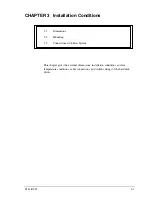
5.
1-35 Main Reactance (Xh)
6.
1-36 Iron Loss Resistance (Rfe)
Application-specific adjustment when running VVC
+
VVC
+
is the most robust control mode. In most situations,
it provides optimum performance without further
adjustments. Run a complete AMA for best performance.
Application-specific adjustment when running Flux
Flux mode is the preferred control mode for optimum
shaft performance in dynamic applications. Perform an
AMA since this control mode requires precise motor data.
Depending on the application, further adjustments may be
required.
See
for application-related recommendations.
Application
Settings
Low-inertia applications
Keep calculated values.
High-inertia applications
1-66 Min. Current at Low Speed
.
Increase current to a value between
default and maximum depending on
the application.
Set ramp times matching the
application. Too fast ramp up causes
an overcurrent or overtorque. Too
fast ramp-down causes an
overvoltage trip.
High load at low speed
1-66 Min. Current at Low Speed
.
Increase current to a value between
default and maximum depending on
the application.
No-load application
Adjust
1-18 Min. Current at No Load
to achieve smoother motor
operation by reducing torque ripple
and vibration.
Flux sensorless only
Adjust
1-53 Model Shift Frequency
.
Example 1: If the motor oscillates at
5 Hz and dynamics performance is
required at 15 Hz, set
1-53 Model
Shift Frequency
to 10 Hz.
Example 2: If the application
involves dynamic load changes at
low speed, reduce
1-53 Model Shift
Frequency
. Observe the motor
behavior to make sure that the
model shift frequency is not
reduced too much. Symptoms of
inappropriate model shift frequency
are motor oscillations or adjustable
frequency drive tripping.
Table 5.6 Recommendations for Flux Applications
5.4.4 PM Motor Set-up
This section describes how to set up a PM motor.
Initial programming steps
To activate PM motor operation, select
[1] PM, non salient
SPM
in
1-10 Motor Construction
. Valid for FC 302 only.
Programming motor data
After selecting a PM motor, the PM motor-related
parameters in parameter groups
1-2* Motor Data
,
1-3* Adv.
Motor Data
and
1-4* Adv. Motor Data II
are active.
The necessary data can be found on the motor nameplate
and in the motor data sheet.
Program the following parameters in the listed order:
1.
1-24 Motor Current
2.
1-25 Motor Nominal Speed
3.
1-26 Motor Cont. Rated Torque
4.
1-39 Motor Poles
Run a complete AMA using
1-29 Automatic Motor
Adaptation (AMA)
[1] Enable Complete AMA
. If a complete
AMA is not performed, the following parameters must be
configured manually.
1.
1-30 Stator Resistance (Rs)
Enter line to common stator winding resistance
(Rs). If only line-line data are available, divide the
line-line value by 2 to achieve the line to
common value.
2.
1-37 d-axis Inductance (Ld)
Enter line to common direct axis inductance of
the PM motor.
If only line-line data are available, divide the line-
line value by 2 to achieve the line-common value.
3.
1-40 Back EMF at 1000 RPM
Enter line-to-line back EMF of PM Motor at
1000 rpm mechanical speed (RMS value). Back
EMF is the voltage generated by a PM motor
when no adjustable frequency drive is connected
and the shaft is turned externally. Back EMF is
normally specified for nominal motor speed or for
1000 rpm measured between two lines. If the
value is not available for a motor speed of
1000 rpm, calculate the correct value as follows: If
back EMF is, e.g., 320 V at 1800 rpm, it can be
calculated at 1000 rpm as follows: Back EMF =
(Voltage/RPM)*1000 = (320/1800)*1000 = 178.
This is the value that must be programmed for
1-40 Back EMF at 1000 RPM
.
Commissioning
Instruction Manual
28
Danfoss A/S © Rev. 09/2014 All rights reserved.
MG33AP22
5
5
















































